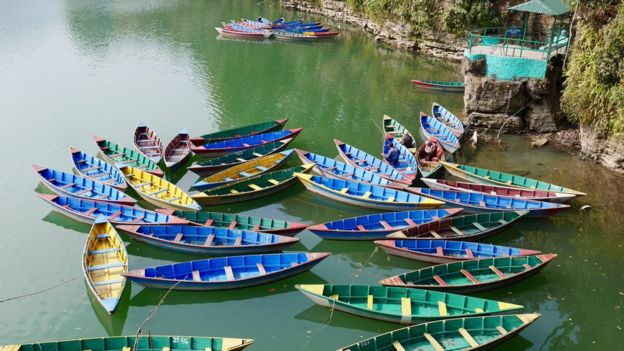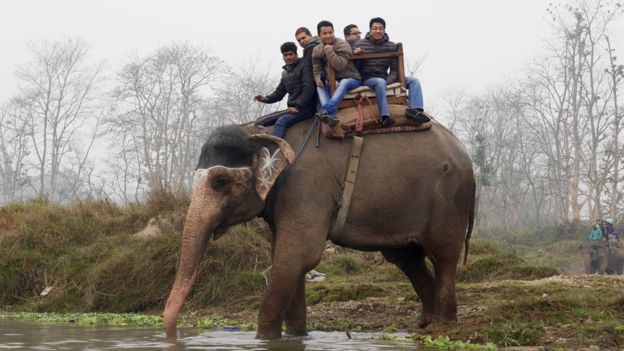BBC News talk about the slow recovery of Nepal’s Tourism industry after earthquake, Here is the story :-
Tourism is the lifeblood of the Nepalese economy, but since the earthquake in 2015 that cost 8,000 lives and left many thousands more homeless, visitors have stayed away. Almost a year later, the country is still struggling to recover.
In Durbar Square in Nepal’s capital, Kathmandu, there are few people who are obviously tourists; just a handful of people eating lunch amongst the piles of bricks.
If anyone resembling a visitor from overseas does turn up, locals in traditional topi caps, saris, flipflops and fleeces, come over waving their laminated badges, saying “official guide, official guide”. They are all desperate for business.
Not that there’s much left to tour.
The royal palaces and temples that dotted the city’s famous square still lie in ruins, a year after the 7.8 magnitude quake shook the valley.
Four hundred years ago this was a network of royal palaces, stables, temples – now it’s mostly rubble.
Fewer tourists
Nobody has tidied up; so the magnificent 17th and 18th Century buildings are now riddled with cracks and interspersed with piles of dusty red bricks.
At a little wooden hut you buy an entry ticket. Prices have been doubled to 1,000 rupees ($10) to raise funds for the reconstruction but the process hasn’t got very far.
And while there are no official figures available, locals say that tourist numbers are down by at least a third since the quake.

Chhiring Gurung, like many Nepalis, is naturally optimistic. He has just returned from a trip taking a group of visitors around a different set of palaces, less damaged but harder to get to from town, a 45-minute drive away.
He doesn’t like to complain. Instead he talks about how beautiful the weather has been, yet the past year has been very hard.
His company, Snowlion Experiences, was set up just over a year ago to take tourists to Nepal’s most exciting sights. Bad timing, he admits.
“We are hoping 2016 will see a pick-up in business. We are seeing some inquiries coming in, but nothing confirmed as yet,” he says with a smile.
Trade battle
Along with the dent in tourist numbers, Nepal faces a host of challenges. The damaged road network requires huge investment.
Some of the mountain passes previously used for trekking are still deemed unsafe, while the country’s power infrastructure has never been reliable.
On top of those concerns, Nepal has also been affected by a dispute with India which resulted in six months of trade restrictions.
That only made life in Nepal harder.
“The price of essential items went up about three times, we have to get them from the black market,” says Mr Gurung. “Fuel and cooking gas are not available easily.”

Further west, Nepal’s second city Pokhara lies on the shore of the serene jade-green Phewa Lake. On a clear day the snow peaks are sharply edged against the blue sky.
Tourism businesses cluster along its shore.
In previous seasons the cafes would have been teeming with customers, soaking up the sun, white-water rafting, canoeing or paragliding.
Even though Pokhara was closer to the epicentre of the quake than Kathmandu the city escaped almost unscathed. But it hasn’t avoided the knock-on effects.
Private investment
Pashupati Timalsina manager of tour operators Himalayan Encounters recalls the immediate impact of the quake: “Everyone was frightened,” he says.
“It was busy season, there were a lot of people here, and their phones could not work to share information.”
But even now, things aren’t back to normal. Bookings are down around two-thirds.
Mr Timalsina thinks the government should be doing more to mend roads, and support the tourism industry.
“There is a huge investment in tourism in Nepal, but that comes from private businesses, not the government,” he says.

Private businesses are spending money, visibly. There is a lot of small-scale construction going on, on houses, hotels, swimming pools and yoga retreats. People are optimistically preparing for a new chapter in their lives.
Restaurants are getting around the electricity and energy shortages by developing new strategies such as printing out alternative menus for days when there’s no power available to cook with. The beer will be warm and the food cold, they warn.
Sunil Sherchen has bought in new hand-carved wooden furniture and hammocks for his bar, Taal Rest-O-Bar, down by the lake. It is decorated with the Nepalese equivalent of bunting: rainbow-coloured Tibetan peace flags, and could seat around 40 people.
Today, though, there are only four guests. Mr Sherchen sips his coffee and chain-smokes, but appears quite relaxed. His strategy is changing now.
Instead of targeting purely tourists he’s focusing on the domestic market – young Nepalis – to boost his business.
“They’re not rich, but recently the younger generation has started eating out and travelling, spending the money they earn working abroad in the Middle East or Malaysia,” he says. “This country now survives on the money they send home.”
Tomorrow he’s catering for a local wedding, but because electricity is so unreliable he’s getting most of the work done well in advance. Next week he’ll host a Nepalese music night.
Bankruptcy risk
Many tourist industry firms “have taken out big government loans to keep going,” says Mr Sherchen. “There’s a risk they’ll go bankrupt – everyone is worried.”

Yet for tourists who do venture there, there’s perhaps a silver lining to Nepal’s troubles.
Chitwan National Park near the border with India is a popular wildlife-watching spot. It’s home to rare Bengal tigers, rhinos and gharial crocodiles, and teems with birds from kingfishers to cormorants. There is a lot to be seen on a shoe-string budget.
These days at sunrise, business owners idly gather by the river, hopeful for last-minute customers on walks or canoe trips.
Park guide Bikash Chowdhury says he’s led less than a quarter of the usual number of visitors through the jungle this last year.
“But on the bright side, when it is quiet, you do see more animals,” he adds.
For more visit http://www.bbc.com/news/business-35695602
